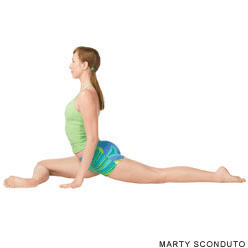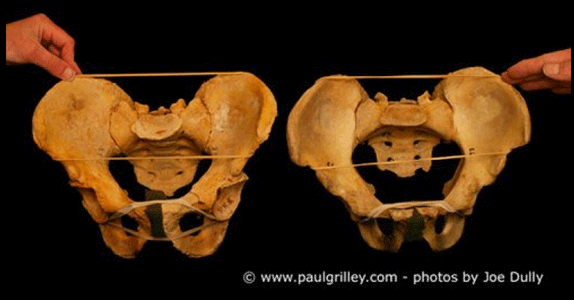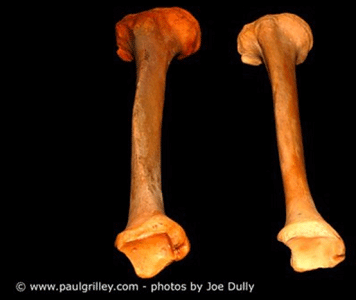By Bernie Clark, July 12th, 2012
Frequently I receive emails or postings from yoga t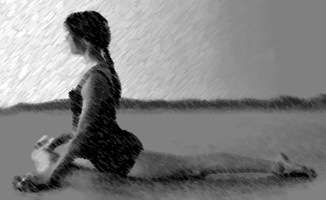 eachers and students asking for an opinion about some other teacher’s statement that a certain yoga pose is really harmful for students and should never be taught, or certain movements of the body in a yoga class should be outlawed. Dogma is dangerous! To say that something is always wrong or something should never be done feeds into fear and at best is unhelpful and at worst is harmful. There are two big reasons why some teachers will render these prejudicial statements:
eachers and students asking for an opinion about some other teacher’s statement that a certain yoga pose is really harmful for students and should never be taught, or certain movements of the body in a yoga class should be outlawed. Dogma is dangerous! To say that something is always wrong or something should never be done feeds into fear and at best is unhelpful and at worst is harmful. There are two big reasons why some teachers will render these prejudicial statements:
- A common misperception about the nature and value of stress
- Ignorance of skeletal variations [1]
Let’s investigate how these deficiencies manifest in a yoga class and why they are not serving students well. We will begin first by reciting a few of the most recent questions I have received.
- Please comment on when a teacher claims that Pigeon Pose should be forever outlawed in yoga classes. (He says the lying forward version should be renamed “Dead Pigeon.”)
- Please comment on this video blog where a teacher claims that we should never allow any flexion of the spine (forward folds) during a Yin Yoga class.
- Please comment on the following statement made by a yoga teacher, “Yin Yoga is especially bad for pregnant students because it could lead to a thrombosis or an embolism leading to a stroke or heart attack!”
This is not a complete list of dogmatic assertions that you may come across in a yoga studio, but it is good representation of the two biggest challenges we have in yoga today. Let’s dive right in and shine a light first on “stress.”
The Value of Stress
Stress has a negative reputation in our culture: we seem to think that stress is bad but this cannot be – without stress we would all die. Problems occur when we over-stress the body and do not allow enough rest to recover from the stress. In a yoga class we can divide stress into three types: we stretch our tissues, compress our tissues or twist them (technically referred to as “shear”) – this is basically all we do to our body in yoga. For some reason yoga teachers have decided that stretching is an okay form of stress but compression is not. You will often hear even very experienced teachers warn students against compression, for example in the lower back: they will use very negative imagery to hammer home the point: “Don’t jam into your lower back!” Another example: we are not allowed to let our shoulders ride up towards the ears because that would mean we are compressing the neck. The idea is – compression is bad. But is it?
If compression were bad, every massage therapist would be out of work and walking would one of the worst forms of exercise. We need to compress tissues in order to stimulate the body at a cellular level. Compression stimulates healing. We can take the example of bones: we have known for over 100 years that bones can be coaxed into growing thicker and stronger if the bones are subjected to compressive stress. If we take the stress away, the bones atrophy. Space studies have shown that astronauts who experience no stress on their bones will lose significant amount of calcium and their bones atrophy to the point that many astronauts cannot walk after coming back to earth. (This is known as “disuse osteoporosis.”)
Joints are comprised of bones, cartilage and the ligaments comprising the joint capsule: all these tissues need stress to be healthy. Usually the stress comes through compression. Stressing the ligaments causes cells called fibroblasts to be active: they secrete hyaluronic acid to help lubricate the joint’s movement and collagen to thicken and reinforce the joint capsule. Stressing the cartilage stimulates chondrocytes to secrete collagen used to strengthen and repair the cartilage. We need to stress our joints! But we need to stress them appropriately: being yin-like tissues, bones, cartilage and ligaments do best when stressed in a long held, static way. Repeated, rhythmic stress could damage these tissues in the same way a credit card is damages by repeatedly bending it back and forth. Our back vertebrae and our sacroiliac joints need stress! Without it they decay.
However! We can do too much of anything. Too much stress can lead to a degeneration of tissues. As described in The Complete Guide to Yin Yoga, we need to find the Goldilocks’ position: not too much and not too little. This can be shown graphically: below you will see a classic n-shape curve that illustrates the danger of being outside the optimal bounds.
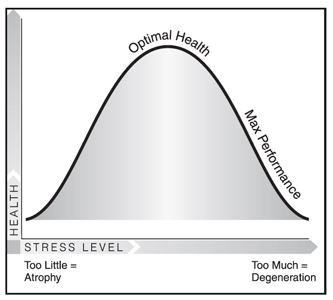
If we apply too little stress to our tissues, they atrophy. All living things require some stress to be healthy! If we apply too much stress, however, tissues degenerate. There have been many scientific studies verifying the n-shaped curve shown in the above graph [see Lower Back Disorders by McGill: page 32 for several references.]
Some stress is good, a lot of stress can be bad: how do we know the difference? Pain! The body will generally warn you when you are going too deep or holding the stress for too long. Stressing tissue brings down the tolerance level of that tissue. This is what exercise is all about: we stress tissues to make them weaker, at least initially. Once we release the stress, the tissues recover and become stronger. If we apply too much stress, or hold for too long or do not allow enough rest, then we are in danger.
The graph below shows how these three variables work together. The curve at the top of the graph shows the level of tolerance the tissue can take before becoming damaged. The lower peaks show the degree of tension or stress being applied through either repetitive stresses or one prolonged steady stress. The horizontal axis represents time.
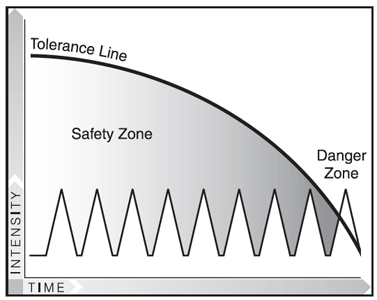
Notice how the amount of stress that our tissues can tolerate decreases with total stress and increased time. Eventually, if we continue to stress the tissues to the point where the two lines cross, damage will occur. This is known as the “last straw effect.” It is a classic occurrence with low back injuries: you bend over at home to pick up your socks and you throw your back out. Worker’s Compensation refuses to cover your injury because it occurred at home. What actually happened was that years of a repetitive stress at work reduced the tolerance of your tissues to the point that one last little stress created a serious injury. This “last straw effect” can also show up in yoga studios: this same person who has for years been reducing the tolerance of her tissues comes into a class, does one particular pose, say Pigeon Pose, and “snap!” – her hip or knee gives her searing pain. She then decides to sue the yoga studio for the injury when it was all the other stresses she had been applying to the area over the years that set up the conditions for the injury to occur.
However, notice the next graph. Here we see the recuperative effect of rest.
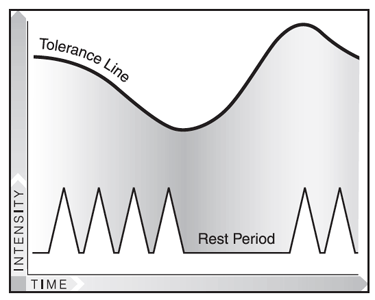
If we stress and then rest the tissue, the tissue’s tolerance level increases above what it was before. The key then is to not over stress the tissue either by having too much stress or holding the stress for too long, but rather allow the tissue enough time to recover and grow stronger.
All tissues need stress. Let’s emphasize that! All tissues: this includes our joints, our bones, our fascia, our muscles, our nerves etc. All tissues: this means that we cannot afford to ignore some areas of the body out of fear of injury. To say as many teachers do that we should never stress our sacroiliac joint is not helpful – no stress there will cause the joint to atrophy, tighten and lose range of motion. Yes, too much stress could lead to arthritis and hyper mobility, but this does not mean that we should avoid stressing the area totally.
The two cases cited earlier of teachers warning students to “never flex your spine when you do a forward fold because you will be stressing the vertebral joints,” or “never do Pigeon Pose because you will stress the SI joint too much” betrays a misunderstanding of the nature and necessity of stress. More helpful is to warn students to avoid stressing any area of the body if they are feeling pain: even little tweaks are to be noticed and avoided because little tweaks lead to big tweak and big tweaks lead to expensive operations, time off work, no yoga practice, which leads to yoga studios going out of business and yoga teachers being out of work – so the moral is – don’t ignore little tweaks! This is a warning against any stress that causes pain: stretching, twisting or compression. But do not be afraid of compression! Tissues need to be compressed to stay healthy.
Now that we understand the nature of stress, let’s look at how this is applied to individuals. We need to understand the nature of skeletal variation.
Skeletal Variation
Every body is different! I am sure that this statement did not rock your world: you know that everyone is different. And yet – knowing this, we somehow expect that everyone should be exactly the same when it comes to yoga practice. This is very dangerous. There is a reason why a ballerina will never play point guard for the Miami Heat and why NFL Linebackers will not dance for the Bolshoi: individual bodies are not built to do all the possible movements that humans on the whole can do. Not every body can do every pose in yoga! But this does not mean that every pose in yoga is dangerous for everybody.
In the blog decrying Pigeon Pose the author showed the following image.
He says, “This student is not only putting her S/I joints in danger, but she is also going to stretch the ligaments out in her knees pretty quickly, and before long will suffer some pretty serious knee trauma.” This displays an ignorance of skeletal variation: this woman is doing this pose because she can! I will never be able to bring my front foot that far forward because my hip sockets will not allow it. For me, and for many others, to even try to do this would destroy my knees, but this does not mean it is dangerous for this particular woman to do so. The only way you can tell if this is dangerous for her is to ask her what she is feeling. If she is feeling any discomfort in the knees then she would be well advised to back off. But many people can greatly externally rotate their legs: some people can bring both feet behind their heads! This pose in and of itself is not dangerous: it can be dangerous to some people but for other people it is perfectly acceptable and is a healthy stress of their hip sockets. Should we say that no-one should do ballet because a 7-foot tall basketball players can’t do it very well?
Paul Grilley has done significant research into this area: he has compiled pictures of the bones that can affect our ultimate range of motion in various yoga poses. These pictures are freely available for anyone to study and we’ll look at just a couple of examples here. (For more information on this topic, check out Paul’s workshops. He definitely will rock your world!)
In almost every yoga class we are told to bring our feet together in Mountain Pose, or at least have them parallel. We will find this same instruction every time our feet are on the ground: in Down Dog – have your feet pointing forward; in Warrior, have your front foot pointing straight ahead; the same for Triangle, Wide-legged forward fold, etc. This dogmatic command has more to do with aesthetics than health. Why should our feet be pointing straight ahead? Because, we are assured, this is the “right” position for our legs and avoids tweaking the knees or the hips. If you are like me, you have been standing and walking for decades without anyone telling you how to point your feet. Next time you are walking down a busy sidewalk, notice the people in front of you – do they all have their feet pointing straight ahead and parallel? No! Why? Because every body is different and everyone’s bones are different. The desire to make everyone conform to a standard is based on aesthetics not function.
Here are two pelvises from Paul Grilley’s “Chicago Collection.” He visited the anatomy lab at the University of Chicago and selected from a group of 30 skeletons the ones with the biggest differences. This is not a sampling of extremes taken across thousands of people! This is a similar sized group that is often found in a yoga class, which means that you may well see this range of variation in your own students. Notice anything different between these two pelvises?
Let me give you a hint: where are the hip sockets? The sockets (known by anatomists as the acetabulum) are pointing forward in the pelvis on the left but are not visible in the pelvis on the right: they are rotated to the side of the pelvis. What will this mean for our students? The owner of the right pelvis is very externally rotated (we will assume that the femurs that insert into the acetabulums are the same, but of course they will have their own variations and implications as well!) The owner of the pelvis on the left is more internally rotated. Who do you think will find it easier to stand with their feet pointing straight ahead? The internally rotated person. Who do you think will find it easier to do the Pigeon Pose as shown above? The externally rotated person. We are not the same and some poses for some of us will be really easy and some poses will be dangerous to try.
I suggested we ignore the femur but the amount of variation there is just as dramatic. Check out Paul’s pictures to see for yourself. We can also look at a lower leg bone, the tibia. Here are two, again taken from the Chicago Collection. Notice any differences?
These are right leg tibias and the difference may seem subtle to you but notice the torsion, which is the technical word for amount of twist in the bone. In the image on the right the bottom square region which sits on top of the talus bone in the ankle is almost parallel to the bottom edge of the photo while the tibia on the left is angled. The bottom right part of the tibia forms the inside of the ankle. Depending upon how much torsion there is in the bone, the foot will be more internally or externally pointed.
When we insist that everyone stand with their feet parallel we are causing some students to internally rotate their legs to accommodate our aesthetic desire. To know what this feels like try this exercise in empathy: come into Mountain Pose, touch your big toes together but move your heels 12 inches apart: you will feel rather pigeon-toed. Now, keep this orientation of your feet while you do some half-sun salutations/forward folds. Notice how uncomfortable that is? But that is exactly what you may be telling some of your students to do because you believe that alignment cues work for every body. They don’t: there is no such thing as universal alignment! There are only alignment cues that work for your body.
Putting it all together:
To bring this learning back to the three statements at the beginning: should we never do Pigeon Pose: is it always deadly for every body? No – we need to stress the sacroiliac joint and many people will have no problem with this pose. Will it be dangerous for some people? Yes! But this does not mean that everyone should avoid it.
A studies of cadavers showed a wide variation in the range of motion of the sacroiliac joint: from 3 to 17 degrees. 17 degrees is a lot and these cadavers were from people who were elderly! For someone who has too much mobility in the sacroiliac joint, care should be taken to not make matters worse: this instability is known as hypermobility and the suggested approach is to strengthen and tighten the joint: Pigeon Pose along with many other poses may not be a good idea for these people. However for people with little mobility, called hypomobility, poses like Pigeon may be just what the doctor ordered to loosen up the joint. If the idea was to never risk stressing the sacroiliac joint, then we’d be well advised to never do Janusirsasana (head-to-knee pose), Hanumanasana (splits), Anjaneyasana (low lunges) and several other poses. The idea in yoga is not to avoid stress but to stress the joint appropriately for your body.
The list of knowledgeable yoga teachers who include Pigeon in their repertoire is impressive: B.K.S. Iyengar teaches it (see Light on Yoga page 389) as does his senior instructors; John Friend includes it as part of the Anusara practice; Leslie Kaminoff includes it in his book Yoga Anatomy; Judith Lasater includes it in her book YogaBody. Dr McCall in his book Yoga as Medicine and Dr Fishman in his book Yoga for Osteoporosis both suggest this pose. Are all these teachers mistaken? If you were to take a class with these senior teachers you will find that they will modify the pose or even leave it out if its inappropriate for a specific student but this doesn’t mean that it should never be taught.
How about flexion of the spine? Should we never allow flexion of the spine in forward folds in Yin Yoga? No – we need to stress the ligaments that wrap the spinal column. Will this be dangerous for some people? Yes! For those people who have herniated disks, bulging disk or many other defined lower back disorders where flexion is not advised, they should not flex the spine. But this does not mean that everyone has to avoid this movement.
The video blog that I cited earlier was short but the teacher commented that we should not flex the spine at all in a long-held Yin Yoga pose. Fortunately, the textual commentary that accompanies the video does qualify what she said verbally: she writes that it is only students who have osteopenia or osteoporosis that should avoid spinal flexion. This I would concur with. Unfortunately, many people have only seen the video and not read the commentary and concluded that flexion is never allowed. Flexion is allowed when it is safe to do so: but again every body is different so you have to determine whether it is a good idea for you to flex your spine in yoga poses.
The last topic: should pregnant women never do Yin Yoga because it may cause thrombosis? I can only speculate that this concern arises due to concerns that immobility for longs periods of time has been linked to conditions such as deep vein thrombosis. This is a problem for people who fly long distances, stuck in the middle seat of an aircraft and don’t get to move their legs. In some instances, a thrombosis (which is a blood clot) can develop and if this clot gets lodged in the brain or the heart’s main arteries a stroke or a heart attack can develop. This obviously is not good! But is this really a worry for pregnant yoga students?
Pregnant women do have thicker blood, probably as a protection against bleeding to death during a dangerous and prolonged delivery. The risk of an embolism is about 4 times higher for pregnant women than non-pregnant women but the overall rate of this occurring is about 1 in 500 deliveries and the death rate due to such complication is 1 in 100,000 deliveries. Pretty small odds, and even then it is not clear at all that this situation is made worse through decreased mobility such as long term bed rest (see Venous Thromboembolism: Mechanisms, Treatment, and Public Awareness by Andra James).
Again, everyone is different, but if not moving for 5 minutes while holding a Yin Yoga pose is dangerous for pregnant women, then they would also be advised to never sit still for more than 5 minutes while reading at home, watching TV or working on a computer. They should also avoid sleeping at night for more than 5 minutes because people are very still for large swaths of time when they sleep. Clearly this is nonsensical. In fact one way you can evaluate dogmatic claims of “never do X” is to think of times in ordinary life when we do do X. For example, when we walk we stress the sacroiliac joint! When we run or play tennis we stress it even more. Clearly it is not always bad to stress the SI joint. Clearly it not always bad to flex the spine. And clearly it is not always bad to sit still for a few minutes at a time.
Conclusions:
Stress is not bad: compression is not bad. Painful compression is not good but painful stress of any sort is not good. We are each unique and what may be good for you maybe very dangerous for me. But just because one person may be harmed by a particular pose does not mean that is has no value for others. Due to our unique anatomy and physiological history we have to take care to make sure any yoga posture works and is appropriate for us. If it is not working, we will usually be told by some complaint of the body. Don’t ignore these early warning signals but don’t be afraid to try postures if your body is able to accommodate the shape. Beware of dogmatic statements: ultimately you have to be the one to decide what works for you.
Footnotes:
(Back to Newsletter #12)
